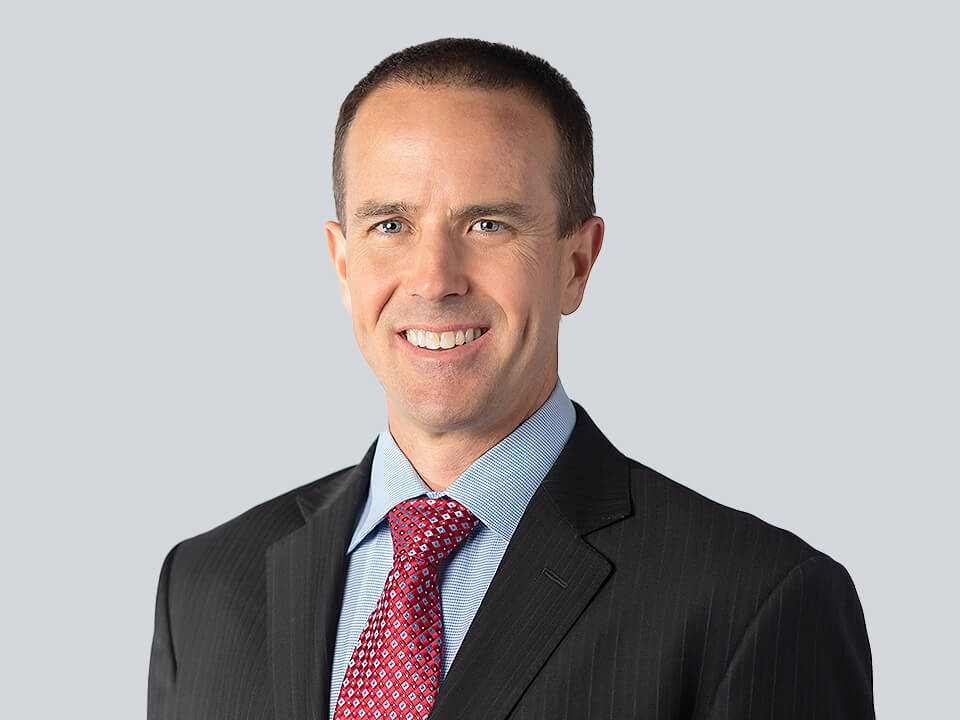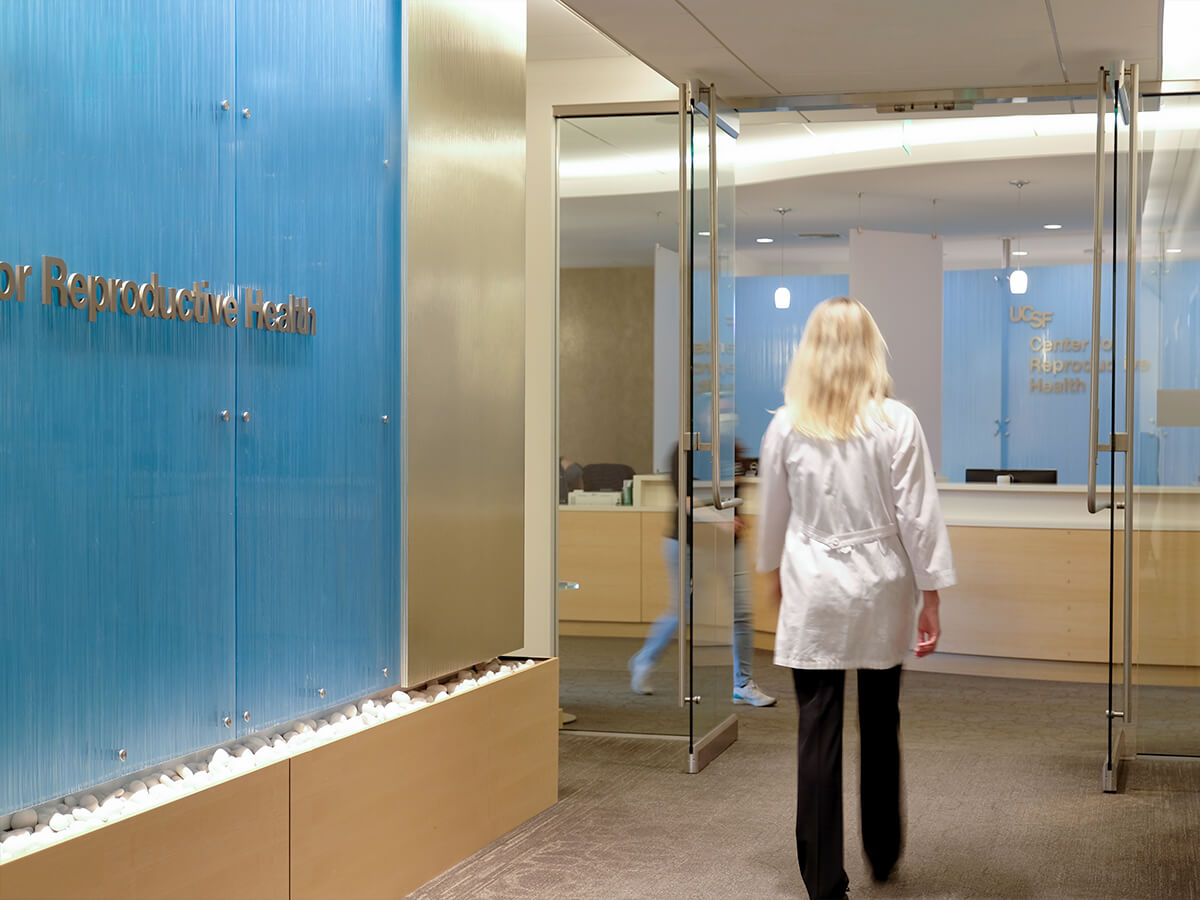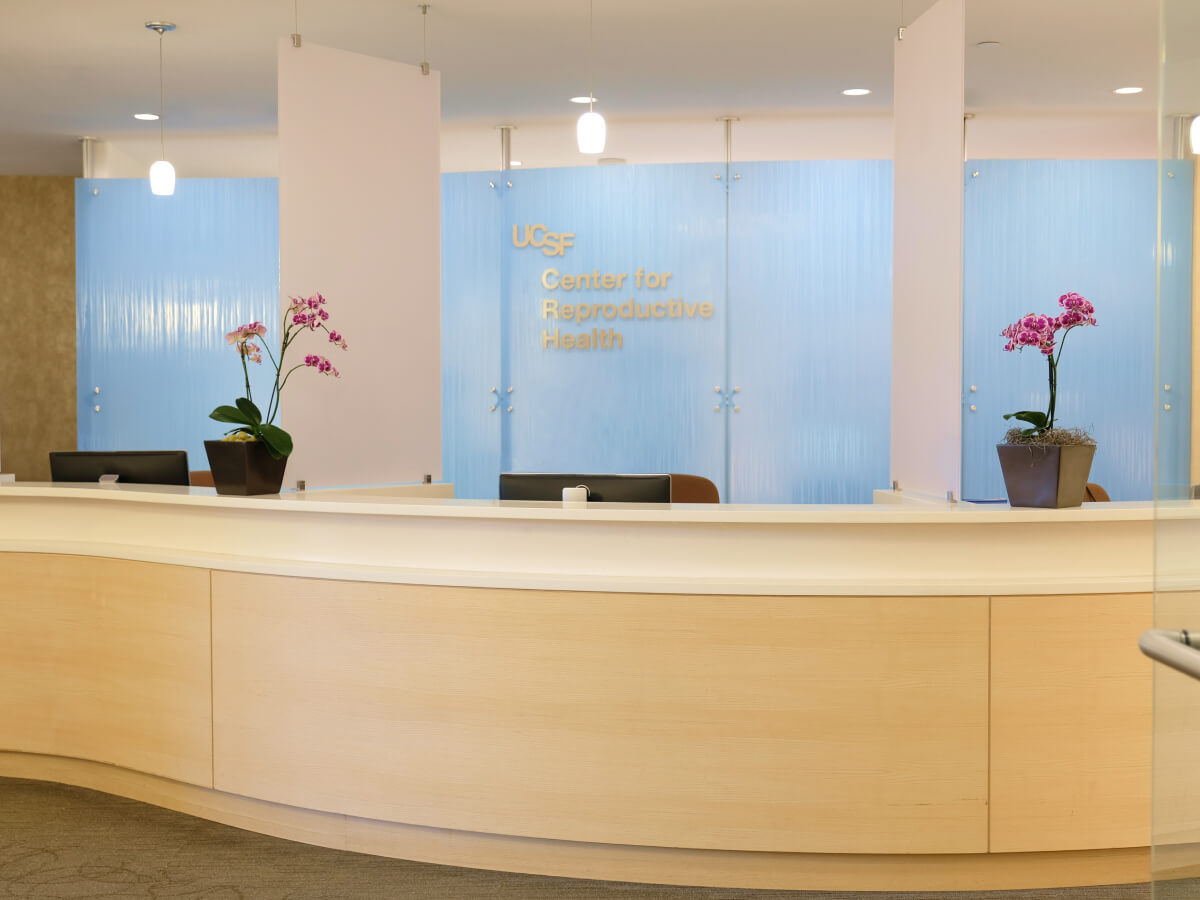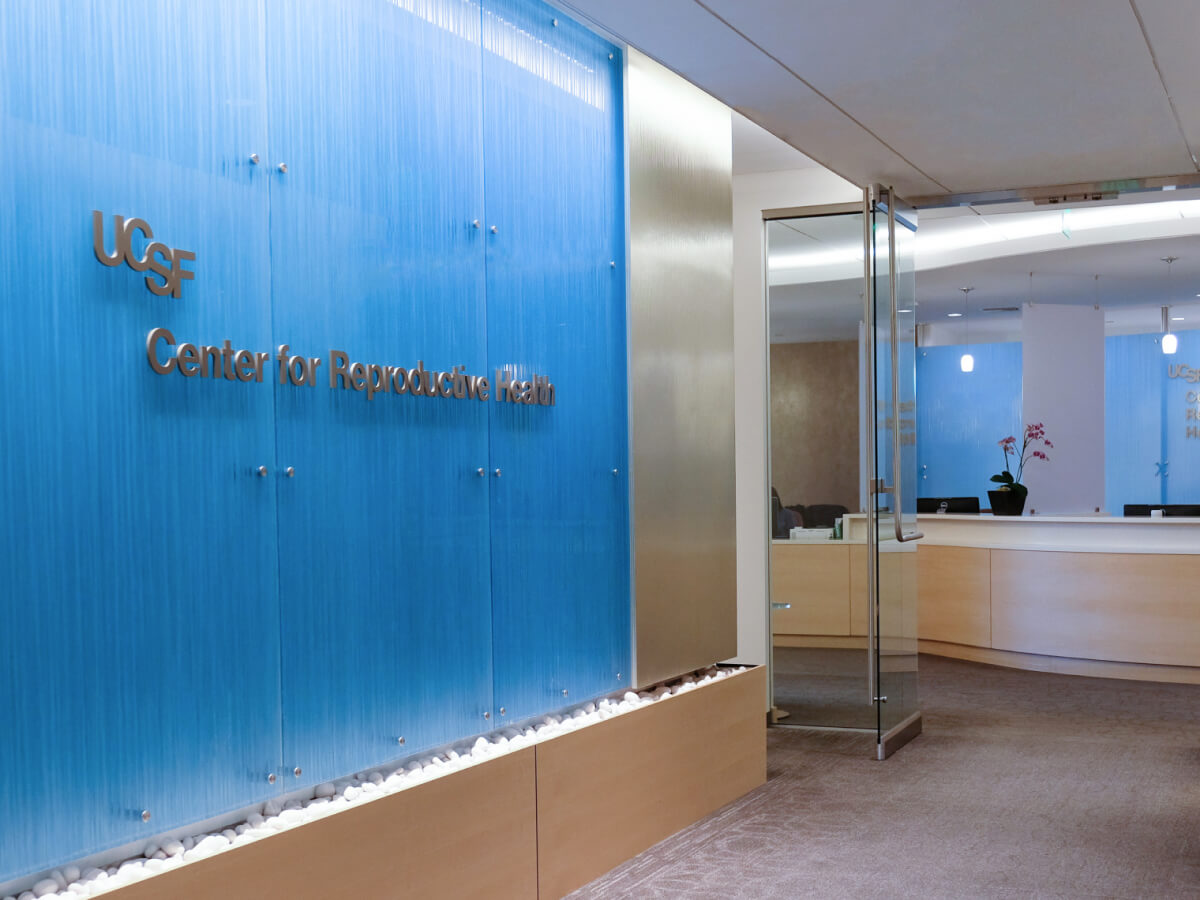Visit us in San Francisco
Academic standards. Pioneering research. Personalized care. Start your journey at the UCSF Center for Reproductive Health, located in Northern California's San Francisco Bay Area.
We are currently booking new patient appointments. Please fill out our form to get started.
UCSF Center for Reproductive Health works closely with the Urology Department and Reproductive Urologists in particular to treat male factor infertility.
The team specializes in the full range of microsurgical procedures and medical treatments currently available for male infertility. Once the diagnostic evaluation is complete, one or more options are chosen to treat the infertile male.
Problems with the male anatomy can often be treated effectively with surgery while medical conditions and the need to enhance sperm production can sometimes be treated using medical therapy. Any treatment may be expected to have an effect on semen quality roughly 3 months after it is started, as this is the length of time required for a single cycle of spermatogenesis (sperm production). If neither surgical nor medical therapy is appropriate, assisted reproductive technologies are available.
In choosing a treatment plan, consideration should be given to the couple's long term goals and financial constraints and the results of the female partner's evaluation in addition to male factor findings.
The decision to pursue medical therapy as an option is based on the specific diagnosis and treatment plan developed for each individual patient. The most successful medical therapy for male infertility involves the reversal of chemical, infectious or endocrine imbalances. This is termed specific therapy and is usually successful because treatment is based upon the correction of well-defined pathophysiologic states. Examples of this include acute prostatitis, epididymitis or varicocele, the replacement of the pituitary hormones (FSH and LH) in radiation or surgically induced pituitary disease, and the treatment of men with low levels of testosterone.
Another kind of treatment is termed empiric therapy and is an attempt to correct rather ill-defined pathologic states. The use of clomiphene citrate, tamoxifen or antioxidants for low sperm density or motility are examples of this form of therapy. These treatments often have limited efficacy, because the generally intact homeostatic mechanisms within the body tend to counteract the intended effect. In other words, hormonal treatments based on the principle that "if some hormone is good, then more is better" are destined to failure and should be avoided.
Ejaculatory failure is the inability to ejaculate. It has a variety of causes that include pelvic nerve damage from diabetes mellitus, multiple sclerosis or abdominal-pelvic surgery and spinal cord injury. It is important to distinguish ejaculatory failure from impotence (the inability to achieve an erection), premature ejaculation (ejaculating before one desires) and retrograde ejaculation (ejaculating into the bladder and not into the penis).
Rectal probe electroejaculation is a commonly performed technique that may enable anejaculatory patients to produce an ejaculate capable of achieving a pregnancy. With rectal probe electroejaculation, the pelvic sympathetic nerves undergo controlled stimulation such that a reflex ejaculation is induced and the semen collected.
The varicocele is defined as dilated and twisted veins within the scrotum, and is basically a consequence of our upright posture. A varicocele can be found in 42% of infertile men and has an unquestioned statistical association with infertility. Interestingly, 15% of normal, fertile men also have a varicocele, a fact which complicates the relationship between infertility and varicoceles. An improvement in semen quality can be expected in roughly 67% of patients who have varicocele ligation, with improvement most likely to be an increase in sperm motility rather than sperm count. The pregnancy rate following varicocele repair is approximately 40%, with pregnancy occurring an average of 9 months after surgery. The varicocele remains the most correctable factor when poor semen quality is discovered, but since it is very common, the operation should only be considered if other infertility risk factors are absent. Varicoceles can be corrected by venous embolization, laparoscopy or through a small inguinal or subinguinal incision.
The male reproductive tract is basically one long tube of varying dimensions. Infection or traumatic injury to the genital tract can result in scarring and blockage within this tube. A classic example of a surgically correctable blockage is a vasectomy. Approximately 5% of men who have a vasectomy undergo a vasectomy reversal. The success of a vasectomy reversal depends on many factors, the most important of which are the skill of the surgeon and the findings at the time of surgery. In the best of circumstances, 85-99% of patients can be expected to have a return of sperm after vasovasostomy (vas to vas connection). With a healthy female partner, this is associated with a pregnancy rate of 60-65%. The surgery is performed as an outpatient and the patient is generally able to return to work in 3-4 days. When congenital absence of the vas deferens is diagnosed, microsurgical reconstruction is generally not possible; however, sperm extraction techniques can be offered to patients.
Ejaculatory duct obstruction is diagnosed in approximately 10% of men without sperm in the ejaculate. The underlying pathology is usually blockage of the ducts within the prostate by stones, cysts, or scar tissue. The condition is effectively treated with a simple, outpatient procedure that involves resectioning the ducts within the prostate. Significant improvements in semen quality occur in 70% of patients so treated, and this is associated with 20-30% pregnancy rates.
Intracytoplasmic sperm injection (ICSI) has revolutionized the treatment of male infertility. The sperm requirement for egg fertilization has dropped from hundreds of thousands for in vitro fertilization (IVF), to one viable sperm required for ICSI when combined with IVF. This has led to the recent development of aggressive new surgical techniques to provide viable sperm for egg fertilization from men with low or no sperm count. This has also pushed urologists beyond the ejaculate and into the male reproductive tract to find sperm for biologic pregnancies. Presently, sources of sperm in otherwise azoospermic (no ejaculated sperm) patients include the vas deferens, epididymis and testicle using sperm aspiration techniques. Sperm aspiration techniques involve the use of minor surgical procedures to collect sperm from organs within the genital tract. These techniques are indicated for men in whom the transport of sperm is not possible because the ductal system that normally carries sperm to the ejaculate is absent (i.e. congenital absence of the vas deferens) or unable to be reconstructed. Most recently, sperm has been fairly reliably extracted (60-70% of the time) from the testes of men with sperm production problems of such severity that no sperm is found in the ejaculatory ducts. It is important to realize, however, that in vitro fertilization (IVF) technology is required to achieve a pregnancy with the vast majority of these extraction procedures, and thus success rates are intimately tied to a complex and complementary program of assisted reproduction for both partners.
Epididymal sperm aspiration can be performed in situations in which the vas deferens is either not present or is scarred from prior surgery, trauma, or infection. Sperm are directly collected from a single, isolated epididymal tubule (MESA) or by blind needle puncture (PESA) in much the same manner as the vasal procedure. Depending on the length of the epididymis that is available for aspiration, multiple, separate aspiration attempts can be made from one or both testicles. When 10-20 million sperm are obtained, the sperm processed for fertilization of the partner's eggs. Epididymal sperm are not as "mature" as sperm that have traversed the entire length of the epididymis and reside in the vas deferens and, as a consequence, epididymal sperm require ICSI to fertilize eggs. Egg fertilization rates of 60-80% and pregnancy rates of approximately 45-55% have been reported with epididymal sperm. Obviously, the results will vary among individuals because of differences in sperm and egg quality as well as the technical proficiency of the lab. Like vasal sperm, these sperm can be frozen at the time of surgery to eliminate future surgical sperm retrieval procedures.
The newest of the aspiration techniques is testicular sperm retrieval. In this procedure, a small amount of testis tissue is taken by biopsy under local anesthesia. It is a breakthrough in that it demonstrates that sperm do not have to "mature" and pass through the epididymis to fertilize an egg. Because of their immaturity, however, testicular sperm need ICSI. Testicular sperm extraction is indicated for patients in whom there is a blockage in the epididymis very near the testis (either from prior surgery, infection or from birth), or a blockage within the ducts of the testes (efferent ductules). It is also used for men with extremely poor sperm production, in which so few sperm are produced that they cannot reach the ejaculate. Pregnancies are now routine in cases of poor sperm production, but there is some concern with the use of this sperm because in most cases the underlying condition causing the poor sperm production is still unknown. Therefore, in these cases, it be must realized that the condition which may have caused the infertility, may be transmitted to the progeny. Recently, even spermatids (round cells that eventually becomes a sperm with a tail) have been used to achieve pregnancies with ICSI. This has raised much speculation and concern, however, about the use of genetic material from a still-evolving germ cell for clinical purposes before the system has been appropriately investigated and its genetic stability examined in animal models. Spermatid injections are currently considered experimental procedures. One drawback of testis sperm is that it does not freeze as readily as epididymal or vasal sperm and thus it is more likely that the male partner will need to undergo repeated procedures for each IVF attempt.
This technique addresses the issue of how to detect ICSI-compatible, mature sperm within failing or atrophic testes. It is based on prior observations that sperm production can be "patchy" or "focal" within the failing testis. This led to the idea that the more sites that are sampled within the testis to look for sperm, the higher the chances of usable sperm. Information derived from "mapping" can be used a) to help infertile couples decide whether or not to proceed to IVF and ICSI and b) to actually locate and find sperm for ICSI within atrophic testes.

Dr. Smith received his undergraduate training from the University of California, Berkeley, where he obtained a degree in molecular biology with high honors. He then enrolled in the University of California's Joint Medical Program, a partnership between Berkeley's School of Public Health and San Francisco's School of Medicine where he earned a master's degree in health and medical science in 2000 and a medical degree in 2002. Smith completed his general surgery and urology training at the University of Utah in Salt Lake City, returning to the University of California, San Francisco as an Andrology Fellow in 2007 for advanced clinical and clinical research training in male reproductive and sexual health under the guidance of Tom Lue, MD and Ira Sharlip, MD. In 2009, he was awarded a K12 MRHR (Male Reproductive Health Research) grant to continue his investigation into male reproductive health.
Academic standards. Pioneering research. Personalized care. Start your journey at the UCSF Center for Reproductive Health, located in Northern California's San Francisco Bay Area.
Academic standards. Pioneering research. Personalized care. Start your journey at the UCSF Center for Reproductive Health, located in Northern California's San Francisco Bay Area.






